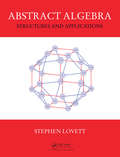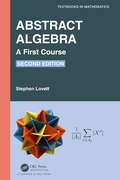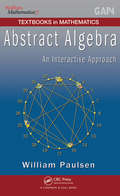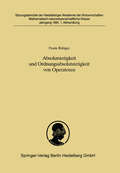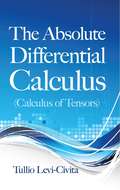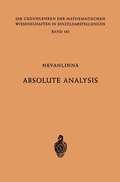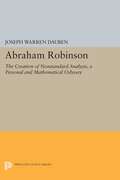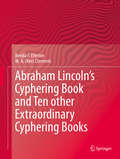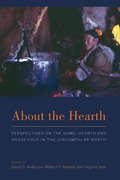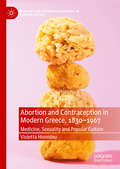- Table View
- List View
Abstract Algebra: Structures and Applications
by Stephen LovettA Discovery-Based Approach to Learning about Algebraic StructuresAbstract Algebra: Structures and Applications helps students understand the abstraction of modern algebra. It emphasizes the more general concept of an algebraic structure while simultaneously covering applications. The text can be used in a variety of courses, from a one-semester int
Abstract Algebra: A First Course (Textbooks in Mathematics)
by Stephen LovettWhen a student of mathematics studies abstract algebra, he or she inevitably faces questions in the vein of, "What is abstract algebra" or "What makes it abstract?" Algebra, in its broadest sense, describes a way of thinking about classes of sets equipped with binary operations. In high school algebra, a student explores properties of operations (+, −, ×, and ÷) on real numbers. Abstract algebra studies properties of operations without specifying what types of number or object we work with. Any theorem established in the abstract context holds not only for real numbers but for every possible algebraic structure that has operations with the stated properties. This textbook intends to serve as a first course in abstract algebra. The selection of topics serves both of the common trends in such a course: a balanced introduction to groups, rings, and fields; or a course that primarily emphasizes group theory. The writing style is student-centered, conscientiously motivating definitions and offering many illustrative examples. Various sections or sometimes just examples or exercises introduce applications to geometry, number theory, cryptography and many other areas. This book offers a unique feature in the lists of projects at the end of each section. the author does not view projects as just something extra or cute, but rather an opportunity for a student to work on and demonstrate their potential for open-ended investigation. The projects ideas come in two flavors: investigative or expository. The investigative projects briefly present a topic and posed open-ended questions that invite the student to explore the topic, asking and to trying to answer their own questions. Expository projects invite the student to explore a topic with algebraic content or pertain to a particular mathematician’s work through responsible research. The exercises challenge the student to prove new results using the theorems presented in the text. The student then becomes an active participant in the development of the field.
Abstract Algebra: A First Course (Textbooks in Mathematics)
by Stephen LovettWhen a student of mathematics studies abstract algebra, he or she inevitably faces questions in the vein of, "What is abstract algebra" or "What makes it abstract?" Algebra, in its broadest sense, describes a way of thinking about classes of sets equipped with binary operations. In high school algebra, a student explores properties of operations (+, −, ×, and ÷) on real numbers. Abstract algebra studies properties of operations without specifying what types of number or object we work with. Any theorem established in the abstract context holds not only for real numbers but for every possible algebraic structure that has operations with the stated properties. This textbook intends to serve as a first course in abstract algebra. The selection of topics serves both of the common trends in such a course: a balanced introduction to groups, rings, and fields; or a course that primarily emphasizes group theory. The writing style is student-centered, conscientiously motivating definitions and offering many illustrative examples. Various sections or sometimes just examples or exercises introduce applications to geometry, number theory, cryptography and many other areas. This book offers a unique feature in the lists of projects at the end of each section. the author does not view projects as just something extra or cute, but rather an opportunity for a student to work on and demonstrate their potential for open-ended investigation. The projects ideas come in two flavors: investigative or expository. The investigative projects briefly present a topic and posed open-ended questions that invite the student to explore the topic, asking and to trying to answer their own questions. Expository projects invite the student to explore a topic with algebraic content or pertain to a particular mathematician’s work through responsible research. The exercises challenge the student to prove new results using the theorems presented in the text. The student then becomes an active participant in the development of the field.
Abstract Algebra: A Comprehensive Treatment (Chapman & Hall/CRC Pure and Applied Mathematics #263)
by Claudia Menini Freddy Van OystaeyenIn one exceptional volume, Abstract Algebra covers subject matter typically taught over the course of two or three years and offers a self-contained presentation, detailed definitions, and excellent chapter-matched exercises to smooth the trajectory of learning algebra from zero to one. Field-tested through advance use in the ERASMUS educational project in Europe, this ambitious, comprehensive book includes an original treatment of representation of finite groups that avoids the use of semisimple ring theory and explains sets, maps, posets, lattices, and other essentials of the algebraic language; Peano's axioms and cardinality; groupoids, semigroups, monoids, groups; and normal subgroups.
Abstract Algebra: A Gentle Introduction (Textbooks in Mathematics)
by Gary L. Mullen James A. SellersAbstract Algebra: A Gentle Introduction advantages a trend in mathematics textbook publishing towards smaller, less expensive and brief introductions to primary courses. The authors move away from the ‘everything for everyone’ approach so common in textbooks. Instead, they provide the reader with coverage of numerous algebraic topics to cover the most important areas of abstract algebra. Through a careful selection of topics, supported by interesting applications, the authors Intend the book to be used for a one-semester course in abstract algebra. It is suitable for an introductory course in for mathematics majors. The text is also very suitable for education majors who need to have an introduction to the topic. As textbooks go through various editions and authors employ the suggestions of numerous well-intentioned reviewers, these book become larger and larger and subsequently more expensive. This book is meant to counter that process. Here students are given a "gentle introduction," meant to provide enough for a course, yet also enough to encourage them toward future study of the topic. Features Groups before rings approach Interesting modern applications Appendix includes mathematical induction, the well-ordering principle, sets, functions, permutations, matrices, and complex nubers. Numerous exercises at the end of each section Chapter "Hint and Partial Solutions" offers built in solutions manual
Abstract Algebra: A Comprehensive Treatment (Pure and Applied Mathematics)
by Freddy Van Oystaeyen Claudia MeniniIn one exceptional volume, Abstract Algebra covers subject matter typically taught over the course of two or three years and offers a self-contained presentation, detailed definitions, and excellent chapter-matched exercises to smooth the trajectory of learning algebra from zero to one. Field-tested through advance use in the ERASMUS educational project in Europe, this ambitious, comprehensive book includes an original treatment of representation of finite groups that avoids the use of semisimple ring theory and explains sets, maps, posets, lattices, and other essentials of the algebraic language; Peano's axioms and cardinality; groupoids, semigroups, monoids, groups; and normal subgroups.
Abstract Algebra: An Interactive Approach, Second Edition (Textbooks in Mathematics)
by William PaulsenThe new edition of Abstract Algebra: An Interactive Approach presents a hands-on and traditional approach to learning groups, rings, and fields. It then goes further to offer optional technology use to create opportunities for interactive learning and computer use. This new edition offers a more traditional approach offering additional topics to the primary syllabus placed after primary topics are covered. This creates a more natural flow to the order of the subjects presented. This edition is transformed by historical notes and better explanations of why topics are covered. This innovative textbook shows how students can better grasp difficult algebraic concepts through the use of computer programs. It encourages students to experiment with various applications of abstract algebra, thereby obtaining a real-world perspective of this area. Each chapter includes, corresponding Sage notebooks, traditional exercises, and several interactive computer problems that utilize Sage and Mathematica® to explore groups, rings, fields and additional topics. This text does not sacrifice mathematical rigor. It covers classical proofs, such as Abel’s theorem, as well as many topics not found in most standard introductory texts. The author explores semi-direct products, polycyclic groups, Rubik’s Cube®-like puzzles, and Wedderburn’s theorem. The author also incorporates problem sequences that allow students to delve into interesting topics, including Fermat’s two square theorem.
Abstract Algebra: An Interactive Approach (Textbooks In Mathematics Ser.)
by William PaulsenBy integrating the use of GAP and Mathematica, Abstract Algebra: An Interactive Approach presents a hands-on approach to learning about groups, rings, and fields. Each chapter includes both GAP and Mathematica commands, corresponding Mathematica notebooks, traditional exercises, and several interactive computer problems that utilize GAP and Mathema
Abstract Algebra: An Interactive Approach, Second Edition (Textbooks in Mathematics)
by William PaulsenThe new edition of Abstract Algebra: An Interactive Approach presents a hands-on and traditional approach to learning groups, rings, and fields. It then goes further to offer optional technology use to create opportunities for interactive learning and computer use. This new edition offers a more traditional approach offering additional topics to the primary syllabus placed after primary topics are covered. This creates a more natural flow to the order of the subjects presented. This edition is transformed by historical notes and better explanations of why topics are covered. This innovative textbook shows how students can better grasp difficult algebraic concepts through the use of computer programs. It encourages students to experiment with various applications of abstract algebra, thereby obtaining a real-world perspective of this area. Each chapter includes, corresponding Sage notebooks, traditional exercises, and several interactive computer problems that utilize Sage and Mathematica® to explore groups, rings, fields and additional topics. This text does not sacrifice mathematical rigor. It covers classical proofs, such as Abel’s theorem, as well as many topics not found in most standard introductory texts. The author explores semi-direct products, polycyclic groups, Rubik’s Cube®-like puzzles, and Wedderburn’s theorem. The author also incorporates problem sequences that allow students to delve into interesting topics, including Fermat’s two square theorem.
Absolutstetigkeit und Ordnungsabsolutstetigkeit von Operatoren: Vorgelegt in der Sitzung vom 30. Juni 1990 von Helmut H. Schaefer (Sitzungsberichte der Heidelberger Akademie der Wissenschaften #1991 / 1)
by Frank RäbigerAbsolute Summability of Fourier Series and Orthogonal Series (Lecture Notes in Mathematics #1067)
by Y. OkuyamaAbsolute Stability of Nonlinear Control Systems (Mathematics and its Applications #5)
by Xiao-Xin LiaoAs is well-known, a control system always works under a variety of accidental or continued disturbances. Therefore, in designing and analysing the control system, stability is the first thing to be considered. Classic control theory was basically limited to a discussion of linear systems with constant coefficients. The fundamental tools for such studies were the Routh-Hurwitz algebraic criterion and the Nyquist geometric criterion. However, modern control theory mainly deals with nonlinear problems. The stability analysis of nonlinear control systems based on Liapunov stability theory can be traced back to the Russian school of stability. In 1944, the Russian mathematician Lurie, a specialist in control theory, discussed the stability of an autopilot. The well-known Lurie problem and the concept of absolute stability are presented, which is of universal significance both in theory and practice. Up until the end of the 1950's, the field of absolute stability was monopolized mainly by Russian scholars such as A. 1. Lurie, M. A. Aizeman, A. M. Letov and others. At the beginning of the 1960's, some famous American mathematicians such as J. P. LaSalle, S. Lefschetz and R. E. Kalman engaged themself in this field. Meanwhile, the Romanian scholar Popov presented a well-known frequency criterion and consequently ma de a decisive breakthrough in the study of absolute stability.
Absolute Stability of Nonlinear Control Systems (Mathematical Modelling: Theory and Applications #25)
by Xiaoxin Liao Pei YuFollowing the recent developments in the field of absolute stability, Prof. Xiaoxin Liao, in conjunction with Prof. Pei Yu, has created a second edition of his seminal work on the subject. Liao begins with an introduction to the Lurie problem and Lurie control system, before moving on to the simple algebraic sufficient conditions for the absolute stability of autonomous and non-autonomous ODE systems, as well as several special classes of Lurie-type systems. The focus of the book then shifts toward the new results and research that have appeared in the decade since the first edition was published. This book is aimed to be used by undergraduates in the areas of applied mathematics, nonlinear control systems, and chaos control and synchronisation, but may also be useful as a reference for researchers and engineers. The book is self-contained, though a basic knowledge of calculus, linear system and matrix theory, and ordinary differential equations is a prerequisite.
Absolute Risk: Methods and Applications in Clinical Management and Public Health (Chapman & Hall/CRC Monographs on Statistics and Applied Probability)
by Ruth M. Pfeiffer Mitchell H. GailAbsolute Risk: Methods and Applications in Clinical Management and Public Health provides theory and examples to demonstrate the importance of absolute risk in counseling patients, devising public health strategies, and clinical management. The book provides sufficient technical detail to allow statisticians, epidemiologists, and clinicians to build, test, and apply models of absolute risk. Features: Provides theoretical basis for modeling absolute risk, including competing risks and cause-specific and cumulative incidence regression Discusses various sampling designs for estimating absolute risk and criteria to evaluate models Provides details on statistical inference for the various sampling designs Discusses criteria for evaluating risk models and comparing risk models, including both general criteria and problem-specific expected losses in well-defined clinical and public health applications Describes many applications encompassing both disease prevention and prognosis, and ranging from counseling individual patients, to clinical decision making, to assessing the impact of risk-based public health strategies Discusses model updating, family-based designs, dynamic projections, and other topics Ruth M. Pfeiffer is a mathematical statistician and Fellow of the American Statistical Association, with interests in risk modeling, dimension reduction, and applications in epidemiology. She developed absolute risk models for breast cancer, colon cancer, melanoma, and second primary thyroid cancer following a childhood cancer diagnosis. Mitchell H. Gail developed the widely used "Gail model" for projecting the absolute risk of invasive breast cancer. He is a medical statistician with interests in statistical methods and applications in epidemiology and molecular medicine. He is a member of the National Academy of Medicine and former President of the American Statistical Association. Both are Senior Investigators in the Division of Cancer Epidemiology and Genetics, National Cancer Institute, National Institutes of Health.
Absolute Risk: Methods and Applications in Clinical Management and Public Health (Chapman & Hall/CRC Monographs on Statistics and Applied Probability)
by Ruth M. Pfeiffer Mitchell H. GailAbsolute Risk: Methods and Applications in Clinical Management and Public Health provides theory and examples to demonstrate the importance of absolute risk in counseling patients, devising public health strategies, and clinical management. The book provides sufficient technical detail to allow statisticians, epidemiologists, and clinicians to build, test, and apply models of absolute risk. Features: Provides theoretical basis for modeling absolute risk, including competing risks and cause-specific and cumulative incidence regression Discusses various sampling designs for estimating absolute risk and criteria to evaluate models Provides details on statistical inference for the various sampling designs Discusses criteria for evaluating risk models and comparing risk models, including both general criteria and problem-specific expected losses in well-defined clinical and public health applications Describes many applications encompassing both disease prevention and prognosis, and ranging from counseling individual patients, to clinical decision making, to assessing the impact of risk-based public health strategies Discusses model updating, family-based designs, dynamic projections, and other topics Ruth M. Pfeiffer is a mathematical statistician and Fellow of the American Statistical Association, with interests in risk modeling, dimension reduction, and applications in epidemiology. She developed absolute risk models for breast cancer, colon cancer, melanoma, and second primary thyroid cancer following a childhood cancer diagnosis. Mitchell H. Gail developed the widely used "Gail model" for projecting the absolute risk of invasive breast cancer. He is a medical statistician with interests in statistical methods and applications in epidemiology and molecular medicine. He is a member of the National Academy of Medicine and former President of the American Statistical Association. Both are Senior Investigators in the Division of Cancer Epidemiology and Genetics, National Cancer Institute, National Institutes of Health.
Absolute Risk: Methods and Applications in Clinical Management and Public Health (Chapman & Hall/CRC Monographs on Statistics and Applied Probability)
by Ruth M. Pfeiffer Mitchell H. GailAbsolute Risk: Methods and Applications in Clinical Management and Public Health provides theory and examples to demonstrate the importance of absolute risk in counseling patients, devising public health strategies, and clinical management. The book provides sufficient technical detail to allow statisticians, epidemiologists, and clinicians to build, test, and apply models of absolute risk. Features: Provides theoretical basis for modeling absolute risk, including competing risks and cause-specific and cumulative incidence regression Discusses various sampling designs for estimating absolute risk and criteria to evaluate models Provides details on statistical inference for the various sampling designs Discusses criteria for evaluating risk models and comparing risk models, including both general criteria and problem-specific expected losses in well-defined clinical and public health applications Describes many applications encompassing both disease prevention and prognosis, and ranging from counseling individual patients, to clinical decision making, to assessing the impact of risk-based public health strategies Discusses model updating, family-based designs, dynamic projections, and other topics Ruth M. Pfeiffer is a mathematical statistician and Fellow of the American Statistical Association, with interests in risk modeling, dimension reduction, and applications in epidemiology. She developed absolute risk models for breast cancer, colon cancer, melanoma, and second primary thyroid cancer following a childhood cancer diagnosis. Mitchell H. Gail developed the widely used "Gail model" for projecting the absolute risk of invasive breast cancer. He is a medical statistician with interests in statistical methods and applications in epidemiology and molecular medicine. He is a member of the National Academy of Medicine and former President of the American Statistical Association. Both are Senior Investigators in the Division of Cancer Epidemiology and Genetics, National Cancer Institute, National Institutes of Health.
The Absolute Galois Group of a Semi-Local Field (Springer Monographs in Mathematics)
by Dan Haran Moshe JardenThis book is devoted to the structure of the absolute Galois groups of certain algebraic extensions of the field of rational numbers. Its main result, a theorem proved by the authors and Florian Pop in 2012, describes the absolute Galois group of distinguished semi-local algebraic (and other) extensions of the rational numbers as free products of the free profinite group on countably many generators and local Galois groups. This is an instance of a positive answer to the generalized inverse problem of Galois theory. Adopting both an arithmetic and probabilistic approach, the book carefully sets out the preliminary material needed to prove the main theorem and its supporting results. In addition, it includes a description of Melnikov's construction of free products of profinite groups and, for the first time in book form, an account of a generalization of the theory of free products of profinite groups and their subgroups. The book will be of interest to researchers in field arithmetic, Galois theory and profinite groups.
The Absolute Differential Calculus: Calculus Of Tensors (Dover Books on Mathematics)
by Tullio Levi-CivitaWritten by a towering figure of twentieth-century mathematics, this classic examines the mathematical background necessary for a grasp of relativity theory. Tullio Levi-Civita provides a thorough treatment of the introductory theories that form the basis for discussions of fundamental quadratic forms and absolute differential calculus, and he further explores physical applications.Part one opens with considerations of functional determinants and matrices, advancing to systems of total differential equations, linear partial differential equations, algebraic foundations, and a geometrical introduction to theory. The second part addresses covariant differentiation, curvature-related Riemann's symbols and properties, differential quadratic forms of classes zero and one, and intrinsic geometry. The final section focuses on physical applications, covering gravitational equations and general relativity.
Absolute Analysis (Grundlehren der mathematischen Wissenschaften #102)
by Frithjof Nevanlinna Rolf NevanlinnaDas vorliegende Werk ist als Ergebnis von Vorlesungen entstanden, welche die Verfasser seit 1953 im Laufe von mehreren Jahren an den Universitäten Helsinki und Zürich gehalten haben. Die nachfolgende Einleitung gibt über die Tendenzen Aufschluß, die für unsere Darstellung der Grundlagen einer absoluten, koordinaten- und dimensionsfreien Infinitesimalrechnung maßgebend gewesen sind. Die Lektüre setzt an Vorkenntnissen nur wenig voraus; sie kann jedem Studierenden emp fohlen werden, der mit dem üblichen, auf die Benutzung von Koordi naten fußenden Aufbau der Elemente der analytischen Geometrie, der Differential- und Integralrechnung und der Theorie der Differential gleichungen vertraut ist. Unsere Arbeit ist durch die Hilfe wesentlich erleichtert worden, die uns von mehreren Seiten zuteil geworden ist. Herr Ilppo Simo Louhi vaara hat von Anfang bis zu Ende an der Herstellung dieses Werkes mit unermüdlichem Interesse und minutiöser Sorgfalt teilgenommen und durch zahlreiche sachliche und formelle Bemerkungen und Vor schläge unsere Arbeit wesentlich gefördert. Für seine wertvolle, auf opfernde Unterstützung sprechen wir hier unseren herzlichen Dank aus. Den Herren H. Keller, T. Klemola, T. Nieminen, Ph. Tondeur und K. 1. Virtanen, die unsere Darstellung im Manuskript gelesen haben, verdanken wir verschiedene wichtige kritische Bemerkungen. Unser Dank gilt auch Herrn Professor Dr. F. K. Schmidt für die Aufnahme dieses Werkes in die Reihe der Grundlehren der mathema tischen Wissenschaften, und dem Springer-Verlag, der unseren Wünschen mit freundlicher Bereitwilligkeit entgegengekommen ist.
Absolute Analysis (Grundlehren der mathematischen Wissenschaften #102)
by Frithjof Nevanlinna Rolf NevanlinnaThe first edition of this book, published in German, came into being as the result of lectures which the authors held over a period of several years since 1953 at the Universities of Helsinki and Zurich. The Introduction, which follows, provides information on what moti vated our presentation of an absolute, coordinate- and dimension-free infinitesimal calculus. Little previous knowledge is presumed of the reader. It can be recom mended to students familiar with the usual structure, based on co ordinates, of the elements of analytic geometry, differential and integral calculus and of the theory of differential equations. We are indebted to H. Keller, T. Klemola, T. Nieminen, Ph. Tondeur and K. 1. Virtanen, who read our presentation in our first manuscript, for important critical remarks. The present new English edition deviates at several points from the first edition (d. Introduction). Professor I. S. Louhivaara has from the beginning to the end taken part in the production of the new edition and has advanced our work by suggestions on both content and form. For his important support we wish to express our hearty thanks. We are indebted also to W. Greub and to H. Haahti for various valuable remarks. Our manuscript for this new edition has been translated into English by Doctor P. Emig. We express to him our gratitude for his careful interest and skillful attention during this work.
Abraham Robinson: The Creation of Nonstandard Analysis, A Personal and Mathematical Odyssey (PDF)
by Joseph Warren DaubenOne of the most prominent mathematicians of the twentieth century, Abraham Robinson discovered and developed nonstandard analysis, a rigorous theory of infinitesimals that he used to unite mathematical logic with the larger body of historic and modern mathematics. In this first biography of Robinson, Joseph Dauben reveals the mathematician's personal life to have been a dramatic one: developing his talents in spite of war and ethnic repression, Robinson personally confronted some of the worst political troubles of our times. With the skill and expertise familiar to readers of Dauben's earlier works, the book combines an explanation of Robinson's revolutionary achievements in pure and applied mathematics with a description of his odyssey from Hitler's Germany to the United States via conflict-ridden Palestine and wartime Europe.Robinson was born in Prussia in 1918. As a boy, he fled with his mother and brother Saul to Palestine. A decade later he narrowly escaped from Paris as the Germans invaded France. Having spent the rest of World War II in England, at the Royal Aircraft Establishment in Farnborough, he began his teaching career at the Royal College of Aeronautics. Subsequently he moved to universities in Canada, Israel, and finally the United States. A joint appointment in mathematics and philosophy at UCLA led to a position at Yale University, where Robinson served as Sterling Professor of Mathematics until his untimely death at the age of fifty-five.Originally published in 1995.The Princeton Legacy Library uses the latest print-on-demand technology to again make available previously out-of-print books from the distinguished backlist of Princeton University Press. These editions preserve the original texts of these important books while presenting them in durable paperback and hardcover editions. The goal of the Princeton Legacy Library is to vastly increase access to the rich scholarly heritage found in the thousands of books published by Princeton University Press since its founding in 1905.
Abraham Lincoln’s Cyphering Book and Ten other Extraordinary Cyphering Books
by Nerida F. Ellerton M. A. ClementsThis well-illustrated book provides strong qualitative and comparative support for the main arguments developed by Nerida Ellerton and Ken Clements in their groundbreaking Rewriting this History of School Mathematics in North America 1607–1861: The Central Role of Cyphering Books. Eleven extraordinary handwritten school mathematics manuscripts are carefully analyzed—six were prepared entirely in Great Britain, four entirely in North America, and 1 partly in Great Britain and partly in North America. The earliest of the 11 cyphering books was prepared around 1630, and the latest in 1835. Seven of the manuscripts were arithmetic cyphering books; three were navigation cyphering books, and one was a mensuration/surveying manuscript.One of the cyphering books examined in this book was prepared, over the period 1819–1826, by a young Abraham Lincoln, when he was attending small one-teacher schools in remote Spencer County, Indiana. Chapter 6 in this book provides the first detailed analysis of young Abraham’s cyphering book—which is easily the oldest surviving Lincoln manuscript. Another cyphering book, this one prepared by William Beattie in 1835, could have been prepared as a special gift for the King of England. The analyses make clear the extent of the control which the cyphering tradition had over school mathematics in North America and Great Britain between 1630 and 1840.In their final chapter Ellerton and Clements identify six lessons from their research into the cyphering tradition which relate to present-day circumstances surrounding school mathematics. These lessons are concerned with sharp differences between intended, implemented and attained curricula, the remarkable value that many students placed upon their cyphering books, the ethnomathematical circumstances which surrounded the preparations of the extraordinary cyphering books, and qualitative differences between British and North American school mathematics.
About the Hearth: Perspectives on the Home, Hearth and Household in the Circumpolar North
by David G. Anderson Robert P. Wishart Virginie VatéDue to changing climates and demographics, questions of policy in the circumpolar north have focused attention on the very structures that people call home. Dwellings lie at the heart of many forms of negotiation. Based on years of in-depth research, this book presents and analyzes how the people of the circumpolar regions conceive, build, memorialize, and live in their dwellings. This book seeks to set a new standard for interdisciplinary work within the humanities and social sciences and includes anthropological work on vernacular architecture, environmental anthropology, household archaeology and demographics.
Abortion and Contraception in Modern Greece, 1830-1967: Medicine, Sexuality and Popular Culture (Medicine and Biomedical Sciences in Modern History)
by Violetta HionidouThe book examines the history of abortion and contraception in Modern Greece from the time of its creation in the 1830s to 1967, soon after the Pill became available. It situates the history of abortion and contraception within the historiography of the fertility decline and the question of whether the decline was due to adjustment to changing social conditions or innovation of contraceptive methods. The study reveals that all methods had been in use for other purposes before they were employed as contraceptives. For example, Greek women were employing emmenagogues well before fertility was controlled; they did so in order to ‘put themselves right’ and to enhance their fertility. When they needed to control their fertility, they employed abortifacients, some of which were also emmenagogues, while others had been used as expellants in earlier times. Curettage was also employed since the late nineteenth century as a cure for sterility; once couples desired to control their fertility curettage was employed to procure abortion. Thus couples did not need to innovate but rather had to repurpose old methods and materials to new birth control methods. Furthermore, the role of physicians was found to have been central in advising and encouraging the use of birth control for ‘health’ reasons, thus facilitating and speeding fertility decline in Greece. All this occurred against the backdrop of a state and a church that were at times neutral and at other times disapproving of fertility control.
